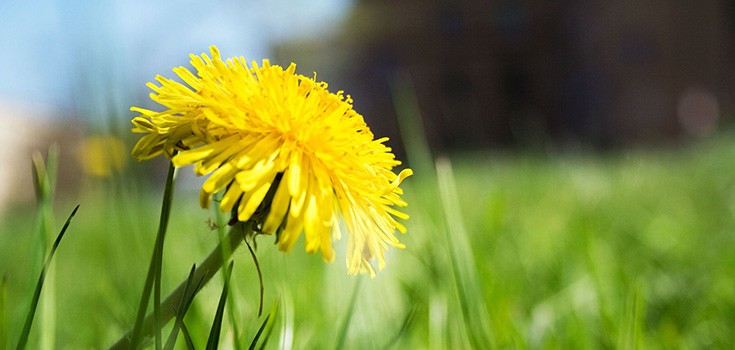Dandelion Benefits: Wild Edibles that Heal

Dandelion is likely the most abundant and most identifiable edible flower in the country. For those people who seek to keep a lush, “weed”-less yard, dandelions are a thorn in their side. They are tough plants and though they aren’t native to the United States, they’ve certainly made themselves at home. But whether growing up through cracks in the sidewalk or all over your lawn, dandelions offer some healthful and tasty benefits. Read on to learn about dandelion benefits and how this over-looked edible can help you.
History of Dandelions
Dandelion use goes back centuries, when it was used in ancient Egypt and Arabia. They’ve been used in traditional Chinese medicine as well as Indian Ayurvedic healing. It’s believed the plant was brought over on the Mayflower intentionally specifically for its healing powers. Some sources say it was brought to provide food for honeybees. Once here, however, the plant spreads like a “weed”.
The plant received its name from the shape of its leaves. Derived from the French dent de lion, dandelion literally means “teeth of the lion.” Cool, huh?
Nutritional Value
Dandelion leaves, or “greens” are perhaps more nutritionally potent than the lettuce you have in your crisper. They contain just as much iron as spinach, and four times as much vitamin A (beta carotene) as the popular salad green. One cup of dandelion also contains 535% of the recommended daily allowance of vitamin K and is a good source of vitamin C, calcium, iron, fiber, and potassium.
Medicinal Uses
There are many uses for dandelions, most of which involve the leaves. Historically and to this day, the leaves are most widely recognized as a promoter of liver health, as they stimulate the production of bile and work to detoxify the blood. One study, from the University of Annunzio Chieti-Pasaca in Italy found dandelion extract to significantly reduce oxidative stress and inflammation in rats with liver damage.
The plant is also a known diuretic, working to increase the amount of urine the body produces, and can be valuable in reducing water weight or blood pressure. It also has digestive benefits, working as a mild appetite stimulant and an upset stomach soother.
Another promising study, published in the Journal of Ethnopharmacology, indicated dandelion root tea was able to kill leukemia cells. Researchers said the active compounds worked to eliminate cancer cells while keeping healthy cells alive. They called it a “novel” non-toxic anti-cancer agent.
The University of Maryland indicates that some studies have shown dandelion to be an effective blood sugar regulator as well. They say it may also work to reduce “bad” cholesterol while increasing “good” cholesterol.
Harvest and Preparation
When harvesting any edibles, be certain they have not been treated with pesticides or “weed killers.”
How you prepare dandelion depends on what parts you are using. Always harvest when the plant is healthy and alive. If you are digging up roots, waiting until after a rain could make the effort easier. When you cut the leaves from the stem or root system, you will see a milky sap. This is where the medicinal properties of the dandelion leaves and roots lie.
- Flowers – A good source of antioxidants; choose the full and bright yellow blossoms.
- Leaves – Used in teas, tinctures, and meals; choose a mixture of young and older leaves.
- Roots – Used in liver tonics, teas, and tinctures; choose the fullest and largest root systems on the most developed plants.
As with most herbals, the easiest way to experience the healing properties of dandelions is with a tea or a tincture. But, because these plants are edible and often included in salads and recipes, you don’t have to stop there.
Both leaves and flowers can be thrown in nearly any salad. The leaves are slightly bitter, so keep this in mind when you are thinking of what to include in your dandelion salad. You can also make a pesto out of dandelion leaves, and freeze what you don’t use. You can add it to soups, sauté it with some garlic, or eat it right out of the ground (we suggest washing it first).
Dandelions are the plants that homeowners despise and children love. But when you consider their healing and nutritional properties (and the cost of prepared dandelion greens), it makes far more sense to harvest the plants than to pull them or treat them with chemicals.
Quick and Brief FAQ
- Common name: Dandelion
- Scientific name: Taraxacum officinale
- Growing regions: Throughout U.S.
- Appearance: Multi-toothed, hairless leaves, bright yellow flowers
- Edible parts: Roots, leaves and flowers
- Safe for pets: Yes

My grandson and I decided one day to see what dandelions taste like. We collected leaves and sauted them with some butter, a little vinegar and a sprinkle of sugar. They were quite good.
Any good book on foraging will have dandelion in it.
Italian immigrants where I lived in NY gathered spring plants. I learned from my friend from Sicily. Spring plants help detox from winter eating. I drew the line at hunting for mushrooms, too risky for an amateur. lol
What about lawn dandelions. Are they edible?
We have eaten dandelion leaves in our salad for several generations. In the south they are used as greens among other things. They are good tasting and Free! But be sure to wash first even before drying. This is a great time of year to stock up on them from your yard before the weed killer goes on. Eat some now, dry some for this winter.
My neighbor has a large crop growing in his front yard, and is kind enough to share the seeds with me 😉
I add apple cider vinegar to counter the bitter flavor.